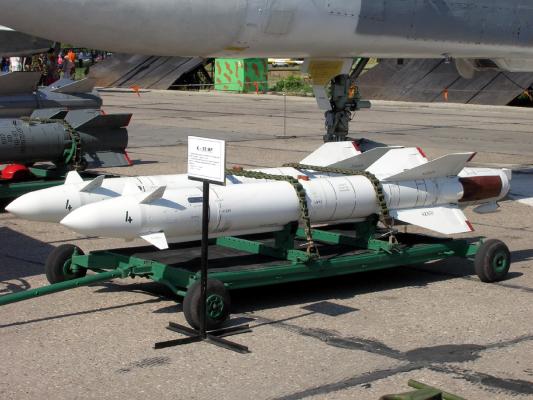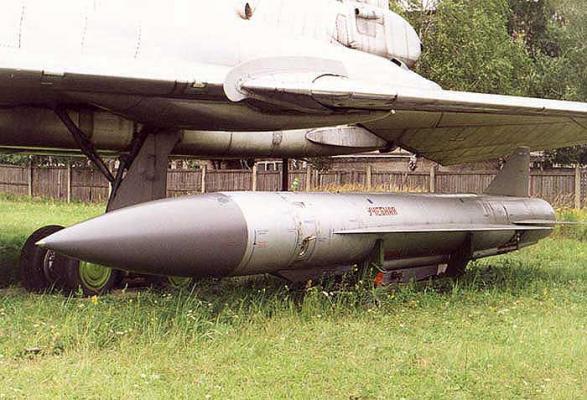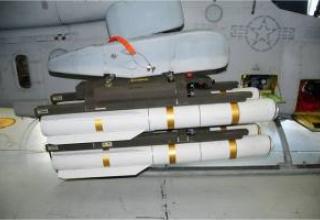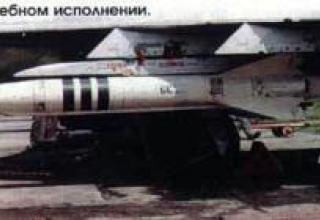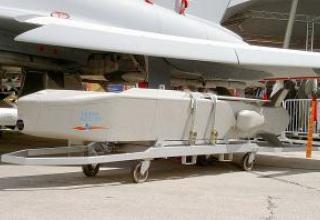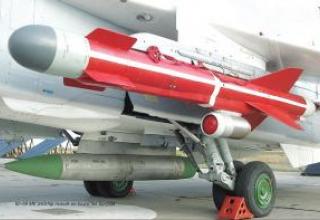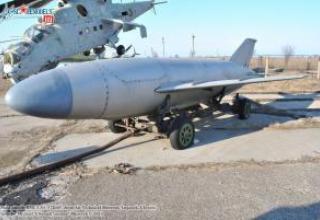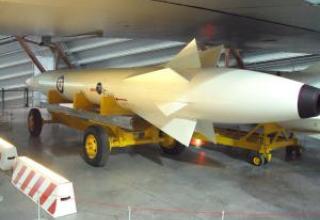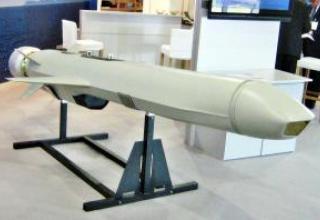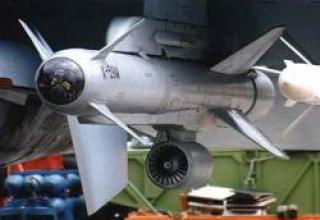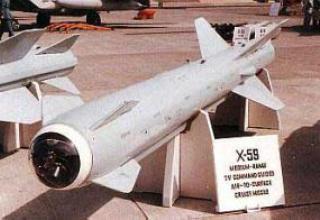Aircraft tactical missile X-25MR with a radio command guidance system is designed to engage small land and single surface targets: the cockpit radar, missile launchers, aircraft in open parking, railway echelons and lightweight ships and vessels.
It is part of a modular family of X-25M missiles.
The main advantage of the missile is its high immunity to interference in conditions of intensive electronic counteraction and relatively low cost.
The developer is Zvezda Design Bureau.
As part of a modular family of missiles X-25M included missiles:
- X-25ML - with laser homing head;
- X-25MR - with a radio command guidance system;
- X-25MP - with a radar passive head of homing.
The X-23 weapon system with X-25MR missiles is used by MiG-23M, MiG-23ML, MiG-27M, MiG-27K, MiG-27D, MiG-23B, Su-17M, Su-22M4, Su-24M and Su-24MK aircraft. All the aeroplanes are equipped with two rockets, while the Su-24MK has four.
Series production of the X-25M family of missiles started in 1982 by the Kaliningrad Arrow Production Association. Series production of Kh--25MR missiles was curtailed by 1993.
In the west, the missile was designated AS-10 "Karen" (AS-7 "Kerry").
Composition:
X-25MR rocket (see projections), like other modular missiles of the X-25M family, is made by the aerodynamic scheme "duck" with an X-shaped arrangement of wing consoles and rudders and includes the following functional systems:
- Glider. Made mainly of aluminum alloys and consists of a body, four wing consoles, each with aileron, and four rudders. The hull is technologically divided into six compartments. All parts of the structure have an anti-corrosion coating;
- The engine is RDTT-324. Designed on the basis of the engine PRD-276 rocket X-27PS, which differs from the use of less smoky fuel and is a solid fuel, dual-mode, single-chamber rocket engine, the steel case which is poured a charge of mixed fuel. The engine has a total impulse of 17200 kg-s, thrust for a time of 0.15...2s more than 2000 kg, running time 5... 11.5 s, fuel weight 82.5 kg, equipped with 122 kg;
- combat unit F-27. Includes an all-welded aluminium alloy hull and explosive charge with a detonator and has a TNT equivalent of 160 kg, which ensures that the AN/MPQ-46 (-48) radar will fail in a zone of credible destruction with a radius of up to 16 metres;
- a contact detonator including a system of contact sensors SKD-24 of three B-24 inertia type sensors and a safety executive mechanism I-255. It ensures detonation of the combat unit before its introduction into the barrier at the missile's encounter speed with the target of 200...900 m/s and approach angle of 2...45° (from the horizon);
- the control system for the UR-17 missile. It is developed on the basis of the control system of the KH-27PS KH-73 missile. Its main difference is the use of the control command formation unit BFKU-89, which consists of a pitch angle sensor and an electronic circuit and differs from the BFKU-79 of the autopilot UR-73 by the introduction of the guidance system feature and the law of switching when the angle of sight exceeds a given value, depending on time. In addition to the BFKU-89, the composition of the SUR-17 includes a control unit BU-42-01, which includes three sensors of angular velocity, two sensors of linear accelerations, a roll sensor and an electronic circuit; two pneumatic steering gear PG-11 to control the course and pitch; pneumatic steering gear PG-10 to stabilize the missile on the roll;
- electric system including ampoule lead battery AB-447 (source of direct current in autonomous flight), power supply unit BP-71 (source of direct current in joint flight and alternating current - in autonomous flight), safety mechanism PM-71, electric wiring with plugs and frequency regulator BRCH-2;
- air system consisting of an ampoule pneumatic block and equipment for air supply to steering drives, rudder bars, ampoule battery start device;
- radio command guidance system B-500. B-500 differs from the "Delta-P2M" equipment of the X-23M missile in smaller dimensions (5 times) and mass (3 times).
All variants of the missile have a common basic module, which houses the control systems, pneumatic and electrical systems, engine, combat equipment, and replaceable bow (GSN on X-25ML and MP, on X-25MR empty fairing, under which the converter with a frequency regulator) and tail compartment (equipment B-500 on X-25MR, fairings on X-25ML and MP).
The X-25MR rocket was obtained from X-25MP by replacing the passive radar GSN on the bow fairing and placement in the 6th compartment of radio command equipment B-500.
X-25MR (product 714) is guided by the classical radio command method on the noise-protected channel. Receiving equipment and trackers for flight tracking are installed in the tail compartment. The return to the seemingly not so perfect method of guidance is explained by some shortcomings of laser munitions and lighting systems. They provided sufficient range of launch only from high altitudes, were sensitive to weather conditions (humid air, smoke and dust weaken the laser beam) and required to accompany the missile by diving to the target (in the systems "Maple" and "Searchlight"), increasing the vulnerability of the aircraft. Another reason to keep in service missiles with radio command guidance was the very presence on the aircraft of these systems - the niche should be filled with something, and the arguments in favor of the X-25MR is not inferior to others. In addition, many foreign customers insisted on keeping such weapons on their cars, which were equipped with an export version of radio command equipment "Delta-NG2E", well mastered by pilots and controlled by the same booklet as the laser beam.
Modern radio command guidance capabilities allow to strike from a horizontal flight without entering the enemy's air defense zone and without constraining the pilot in the maneuver after launch.
Compared with other missiles series X-25M missile X-25MR has an enhanced fragmentation fugasnoe combat unit type F-27, placed in two blocks in the nose and tail of the missile. For the visual support of the missile on it is installed a tracker.
The X-25MR missile is designed to engage the same targets as the X-25ML, and is used in the weapons system of the X-23, which include:
- two or four X-25MR missiles;
- APU-68U, APU-68UM, APU-68UM2, APU-68UMZ launchers with electric control automation;
- radio command control equipment "Delta-N" built on a rocket carrier or placed on it in a hanging container;
- ground control and testing equipment;
- ground control equipment; ground simulator.
Characteristics:
| Start range, km | 2.5-10 |
| Launch altitude range, km | 0.05-5 |
| Start speed range, km/h | 700 - 1350 |
| Maximum flight speed, m/s | 870 |
| Average flight speed at a range of 6 km, m/s | 450 |
| Time of controlled flight, s | 90 |
| Available overload , g | 10 |
| Accuracy (Eqvo), m | 5-6 |
| Dimensions, mm | |
| length | 3686 |
| case diameter | 275 |
| wingspan | 755 |
| Start weight , kg | 299 |
| Weight of combat unit, kg | 140 |
| Transport container | |
| length,mm | 4200 |
| width,mm | 860 |
| height,mm | 806 |
| rocket container weight , kg | 540 |
Testing:
The X-22 missile proved to be a very effective anti-ship vehicle even without a nuclear charge. Tests have shown that in the event of a sea target being hit, the X-22 would cause damage to the target ship, which could disable an aircraft carrier or cruiser. At the take-off speed of 800 m/s, the area of the hole was up to 22 sq.m., and the inner compartments were burned by a cumulative jet to a depth of 12m.
The Soviet leadership considered the aircraft Tu-95K-22 and Tu-22M3 with the X-22 rocket the most effective tool to combat aircraft carriers. Therefore, Soviet heavy aircraft systematically approached the U.S. aircraft carriers and recorded the action of radio electronic interference Americans. According to navigators, the effectiveness of these tools was tremendous: the target markings on the screens literally drowned in a cloud of interference, it became impossible to aim. Therefore, a version of the attack was developed, according to which the first to launch X-22 missiles with nuclear warheads are not on specific targets, and the area where the American aircraft carrier connection was to be. It was believed that after that the action of electronic countermeasures will significantly reduce, and the second wave of X-22 missiles will find surviving targets.
Measures to overcome the air defense included a variety of tactical techniques: massaging efforts of several strike groups, echelonizing the combat orders of missile carriers and air defense aircraft that covered them, maneuvering during an attack. The strike could be delivered by reshaping several units and launching from different directions, frontal attack with salvo launch of dozens of missiles, consecutive disabling of cover ships, weakening of the air defense and defeating the main target. Sometimes a distraction group of aircraft stood out. During combat training, the targets were real AUGs, which were within the reach of missile-borne units. The appearance of potential enemy ship groups near the Soviet shores usually served as an excuse to work out a plan of counteraction with training anxiety and regimental flight. During daily training, crews were limited to tactical launches.
Until the beginning of the 90s, the crews of both YES and Navy conducted combat firing at sea targets in the Caspian Sea, for which the crews from remote airfields moved closer to the firing range during training sessions. Mozdok usually served as a base for "long-range" airfields, and Oktyabrskoye in Crimea served as a base for "sailors". Over time, the range in the Caspian Sea, which had been in operation since the 50s, was closed by environmentalists' demands due to the contamination of the sea with countless missile debris. Problems have also arisen with the organization of shooting at the Akhtuba range, which is now under Kazakhstan's control.
With the removal of weapons Tu-22K and Tu-95K-22 missile system K-22M continued to remain in service, using the aircraft Tu-22M3 - the most modern machines of this type. Equipped with these parts are the basis of the missile forces of the YES and the Navy in Russia and the Ukraine. By 1994, there were 92 aircraft of this type in Ukraine and the Crimea.
In April 1987, the forces of the Russian YES were consolidated into the 37th FA of the Navy. To date, the Tu-22M3 are in service with four of its air regiments, as well as two maritime missile-bearing regiments on the SF and TOF (in the early 80's at the height of Soviet aviation fleet had a fleet of one and a half dozen missile-carrying regiments).
After several years of uncertainty, rocket firing at newly equipped firing ranges also resumed (their arrangement was linked not only to the choice of small, extensive locations for safety requirements in case of missiles or irregular missile behavior, which sometimes happened, but also to the equipment of measuring posts and telemetry control points). For the first time, the Tu-22M3 of the Severomorsk Kirkenes Red Banner Air Division carried out missile launches in the Barents Sea during the Zapad-99 command and staff exercise in northern Russia. Striking together with the missile ships of the fleet, 24-26 June 1999 TU-22M3 "destroyed" detachment cover enemy ships at a range of 100 km, and the "main target" - with 300 km. In September the same year, the TU-22M3 detachment conducted missile firing at targets four X-22.
During a joint exercise of the Air Force of Russia and Ukraine August 11, 2000 a pair of Poltava Tu-22M3 made a five-hour flight to the North and together with 10 Russian aircraft attacked targets at the testing ground near Novaya Zemlya. Although only three pilots had participated in the launches before due to the long break, both target barges were hit.
Two weeks later, on 25th August 2000, the crew of the Ukrainian Tu-22M3 performed an unusual task: providing joint exercises of the Air Forces and Air Defence at the Arkhalyk range, after a long flight it fired an X-22 target missile successfully intercepted and hit by Su-27 fighters.
On 6 April 2001, during a major exercise of the 37th Air Force combined with the Yuzhny Shield-2001 KShU, the X-22 was launched, which was of research nature: a missile that had been stored in a warehouse for 25 years was taken to check reliability. Launch from the board of the Tu-22M3 at the Makat test site was a success, all systems of the X-22 worked off routinely. Less successful were the shooting at the new range near Chita in September 2002 - due to failure in the guidance missile fell in Mongolia, causing a scandal and demands for millions of compensation (the same slippage took place in Kazakhstan, where the X-22 fell near the village).
The X-22 took an exceptional place in domestic aviation and rocket technology - both in terms of the service life of the complex, approaching the 40-year mark, and the universality of application. Unlike other missiles of its class, whose service was limited to a single type of aircraft (in turn, a special modification of which was created for a certain complex of missile weapons). X-22 was armed with three carrier aircraft - Tu-22K, Tu-22M and Tu-95K-22.
However, the long service and improvement of the complex could not save it from a significant disadvantage - low serviceability associated with the use of liquid rockets. The high performance achieved by the use of liquid-propellant missiles, brought with it organic flaws and problems with ensuring the combat readiness of missiles, which required equipment with toxic and caustic components - acid and no less harmful fuel.
Prolonged storage in refueled form proved to be unacceptable due to corrosion resistance of the structure. The use of protective coatings and inhibitors - corrosion retardants - also prevented this threat from being radically eliminated. At one time, the solution was to organize a continuous cycle of work on missiles, in which at the expiration of the period of maintenance of fuel and oxidizer refueled AKR from them, removed BC, the tanks were washed with neutralizing solution, dried, and the missiles were put in storage, while the next stage of the AKR after the equipment was ready for combat duty. The labor-intensiveness of such a "carousel" with maintenance of constant combat readiness created too many obstacles; and the main direction was to improve the refueling technology, which accelerated the process as much as possible and simplified it with due security.
The most effective measure was the introduction of ampoule filling with a special unit. The oxidizer from its sealed pressure vessels was pumped into the rocket tanks, remaining virtually isolated from the environment. Filling was carried out just before firing, and storage of the missiles was no longer permitted. The equipment of the rocket technicians included a protective special suit with a woolen suit to be worn under it, thick rubber gloves on top of ordinary knitted ones, and bashila boots in a thick finger. The equipment was equipped with an insulating gas mask, and the filling process was controlled by a gas analyzer in case of leakage. Labor-intensive operations in combat units were avoided as much as possible, and flights with unpacked missiles became a common practice even at the exercises. In full, their training was carried out only when offsets launches were carried out, at best, during training sessions 1-2 times a year. Shooting was an event, and in practice, given the responsibility, only the most trained crews with similar experience were allowed to fly. The training usually took at least one month, with several rehearsals. The launch always took a couple in which a substitute crew provided backup in case of refusal. Sometimes volley launches were made by a pair of missiles or both crews, including X-22 of different types with radar and inertial guidance.
Sources:
- А.В.Карпенко, С.М. Ганин "Отечественные авиационные тактические ракеты", "Бастион" N1, 2000г.
- Широкорад А.Б. "История авиационного вооружения", -Мн.: Харвест, 1999.-560с.
- "Авиация ВВС России и научно технический прогресс"
- http://karopka.ru/upload/iblock/884/photo_17_1431702664.JPG


